All the tips and tricks to make authentic ragu' sauce recipe - Once you try the original Italian bolognese sauce, there's no going back!
Traditional bolognese ragu' sauce (ragù alla bolognese) is a staple of Italian cuisine, and probably the most famous pasta sauce in the world.
It's a meat tomato pasta sauce originating in Bologna, Italy.
The meat is slowly simmered in its sauce for hours, to help develop a complex flavour and texture.
The result is a comforting, flavor-loaded pasta sauce that melts in your mouth.
To be honest, it’s very difficult to track down the real original recipe, and every single family in Bologna and in Italy has their version.
BUT, the one we are making today is as close as it can be, and it’s the official recipe from the Accademia Italiana della Cucina.

Jump to:
WHAT IS RAGU'?
Italian meat ragu' sauce is typically made by simmering ground meat and veggies in tomato sauce, white wine, milk and stock for a long time (often up until four hours).
This slow cooking process allows the meat to soften and break down into the sauce, creating a unique flavour and texture.
In Italy, we never serve bolognese sauce with spaghetti. Never!
Fresh egg tagliatelle is the official pasta that goes with ragù in Bologna (the famous tagliatelle alla bolognese).
However, you can also serve it with any kind of short pasta with a “hole”, such as mezze maniche, rigatoni, penne pasta, so that the pasta catches up all the tiny meaty bits.
There are many bolognese recipes out there, and most call for lots of tomato sauce.
But in the original one, there's just enough tomato passata or pelati ( tomato puree or whole peeled canned tomatoes) to add a hint of sweetness and another layer of flavor to the sauce.
RAGU' SAUCE INGREDIENTS
It's fair to say that the better the ingredients you use, the better your homemade ragu' sauce will be, so choose them wisely.
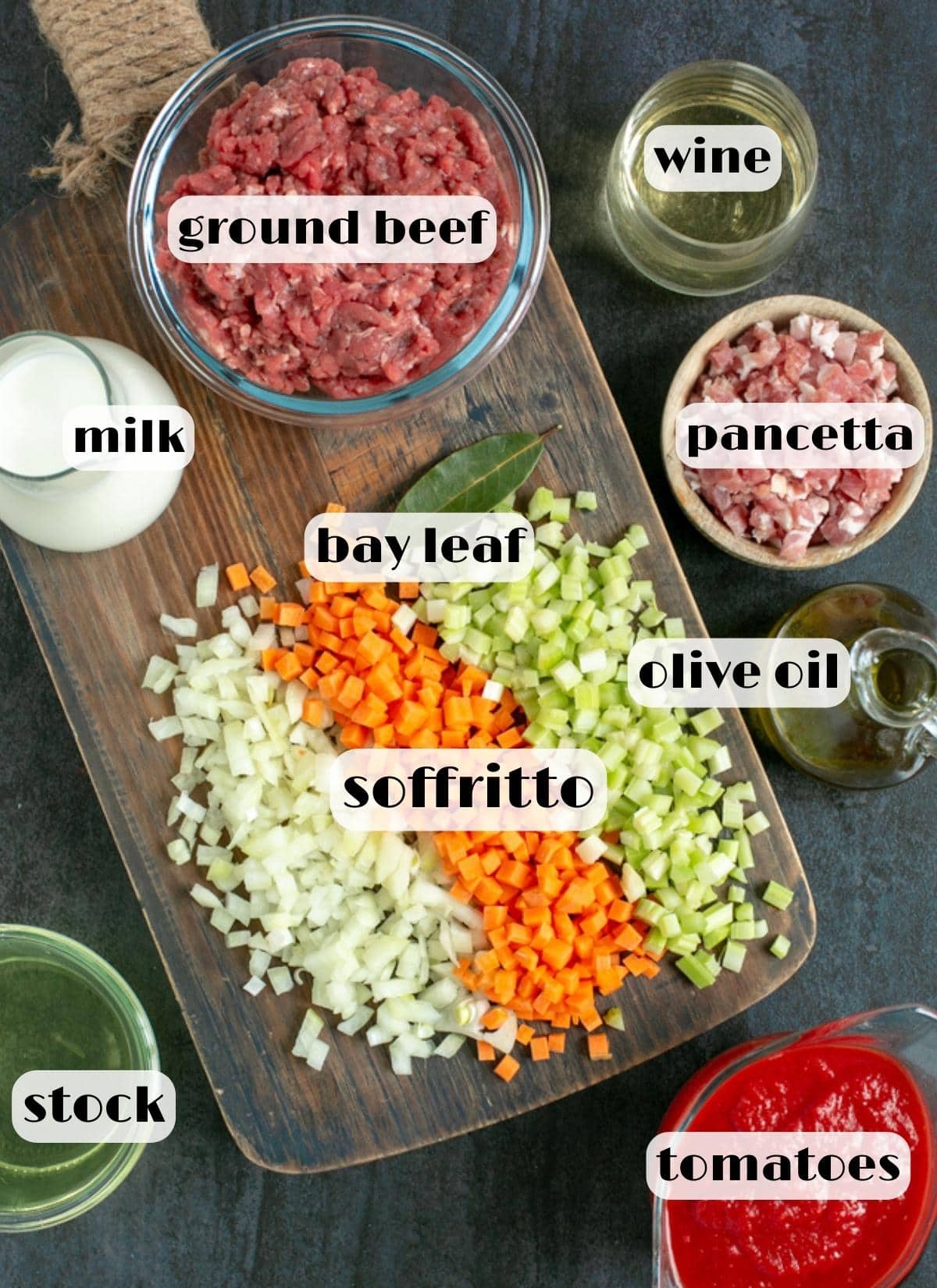
- Beef: Traditionally the meat cut called cartella (near the belly) was used, but nowadays most people use the shoulder. Ask your butcher to fresh-mince the meat for you, making sure the meat is quite coarse and not finely minced.
Note: Pro chefs like to chop the beef by hand using a sharp knife. If you go this route, note that your ragu will need to cook for a couple of hours longer.
- Pancetta: Use pork pancetta or pork belly, but try to go for the sweet kind and not the smoked kind. You can use pork mince as a last resort or just use smoked pancetta - I promise I won't tell anyone.
- Tomatoes: You can use either tomato passata or pelati tomatoes. If using pelati, remove the seeds, as they're bitter. You can use fresh tomatoes (blanch and remove the skin first) or 1-2 tablespoons of triple tomato concentrate (also called tomato paste).
- Vegetables: Most Italian sauces start with a soffritto, basically the Italian mirepoix, made with finely minced carrot, celery and onion.
- Wine: Traditional bolognese needs wine. Use a good red wine or dry white wine with moderate alcohol content (ideally between 10 and 12 percent) and generous acidity. Verdicchio or Sangiovese wines are some of my favorite options.
- Milk: A little milk poured into the sauce towards the end, helps smoother up the acidity from the tomato and tender the meat, so don't skip it.
- Stock: You'll need a little stock whilst you cook the sauce. You can use vegetable, beef or chicken stock.
- Bay leaf: The traditional doesn't feature aromatic herbs, but a bay leaf will balance out the acidity coming from the tomatoes.
HOW TO MAKE TRADITIONAL RAGU'
Once you have the right ingredients, this ragu' meat sauce recipe is pretty straightforward and quite easy to master.
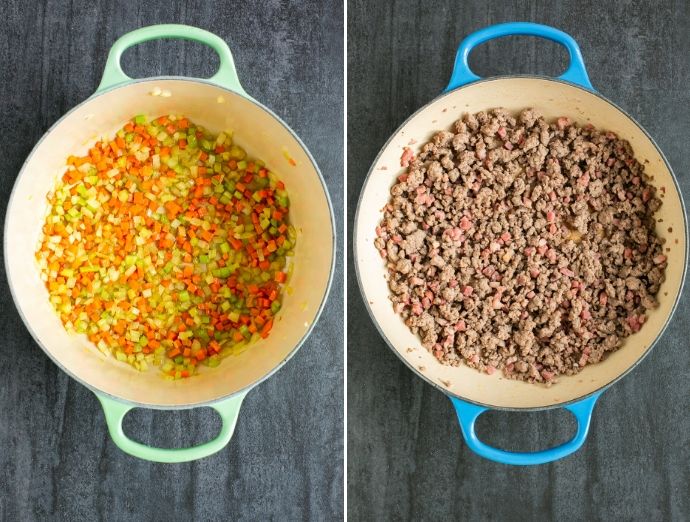
STEP 1. Cook the soffritto vegetables, stirring often, for about 10 minutes, until the veggies have softened.
STEP 2. In another pan, brown the pancetta, then add the ground meat and continue to cook until brown.

STEP 3. Transfer the beef and pancetta into the pot with the veggies, and bring the temperature to medium-high.
STEP 4. Add wine and allow it to evaporate, about 5 minutes.
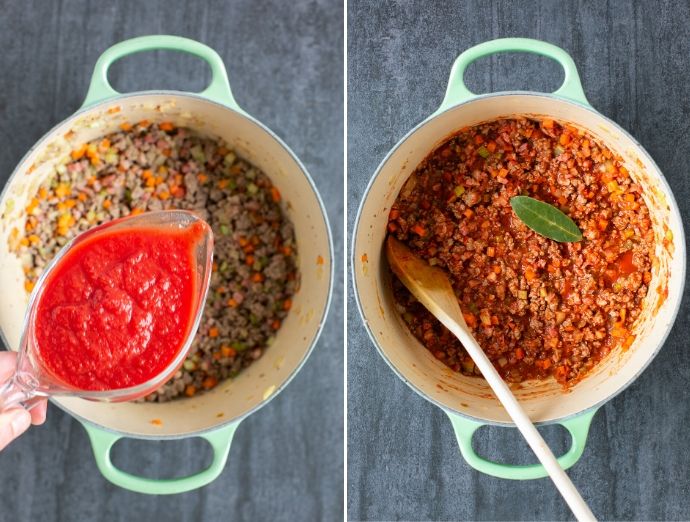
STEP 5. Add the pureed tomatoes, and if you like, add the bay leaf.
STEP 6. Reduce heat to very low, partially cover the pot with a lid, then slowly cook, stirring occasionally, for at least 2 hours.
If you see the sauce drying out, pour in a little stock.
During the last half an hour of cooking, pour in about ½ cup of milk, a little at a time until fully incorporated.
The sauce is ready when it reaches a dense and rich texture.

TIPS FOR THE BEST BOLOGNESE SAUCE
The BEST bolognese sauce recipe is a direct result of the ingredients you use.
However there are a few secrets that will bring your sauce to the next level.
- Chop the veggies by hand. I know that using a food processor might be tempting, but the hand-chopped soffritto gives the ragu' a unique texture.
- Use freshly-minced beef, if possible. Try to avoid prepackaged supermarket minced beef, as it's usually too finely minced and you have no control over the meat cut used.
- The meat and the soffritto need different timings and temperatures to cook, so you need one pan for each of them.
- Brown the meat in one pan, then add it to the pan with the soffritto.
- Alternatively, cook the vegetables first, remove them from the pan, then cook the meat, then add the veggies back in.
- Use a large heavy-duty pan or a cast-iron pot, that will hold the heat steady.
- If you use ground beef, the cooking process should take about 2 hours.
- If you use knife-chopped meat instead you want to slow cook it for up to 4 hours until the meat breaks downs nicely into the sauce.
- The traditional recipe, surprisingly, doesn't call for any kind of aromatic herbs. However, if using tomato passata or pelati, I recommend adding a bay leaf, to help level up the tomato acidity.
- Cooking the bolognese at very low heat is the real secret that will thicken your sauce.
- Leave the salt and pepper out until the very end. The ragu' should be seasoned once it is cooked through.

WHAT SHOULD YOU SERVE WITH AUTHENTIC BOLOGNESE SAUCE?
Pasta with ragu' sauce is the way to go. Use fresh egg tagliatelle pasta or pappardelle.
And even though it's not traditional, you can serve it with spaghetti too.
In northern Italy, ragu' is also served on top of polenta and it's absolutely delicious.
STORAGE TIPS
Once cooked through, allow the sauce to cool.
Divide the bolognese sauce among freezer-friendly containers, and store it in the freezer for up to 1 month.
Bolognese keeps well in the fridge for up to 2 days.
RECIPE FAQs
Yes, you can! I actually highly recommend making a big batch of ragu' and freezing it for later.
Divide leftovers into freezer-friendly containers and store them in the freezer for up to 3 months. Thaw in the refrigerator overnight before use.
You can also use this meat sauce to stuff cannelloni or make classic lasagna. And while it's not traditional by any means, you can also use leftover bolognese as a base for Shepherd's pie.
MORE TRADITIONAL ITALIAN RECIPES
If you enjoyed this great recipe, I'm pretty confident you'll love these classic Italian recipes just as much:
DID YOU MAKE THIS RECIPE?
Please let me know how you liked it! Leave a comment below and share a picture on Instagram with the hashtag #thepetitecook! Looking at your pictures always makes me smile *and super hungry*!
Recipe
Traditional Ragu Sauce - Bolognese
Ingredients
- 3 tablespoon extra-virgin olive oil
- 50 g carrot, finely cubed
- 50 g celery, finely cubed
- 50 g golden onion, finely cubed
- 150 g raw pancetta, finely cubed
- 300 g ground beef, (preferably shoulder cut)
- 200 ml dry white wine
- 300 ml pureed tomatoes, or 3 tablespoon triple concentrate tomato paste
- 1 bay leaf, optional
- 100 ml vegetable stock, or brodo di pollo (chicken stock)
- 120 ml fresh whole milk
Instructions
- Heat a large pot with 2 tablespoons of olive oil over low heat. Fold in the carrot, celery and onion and cook, stirring often for about 10 minutes, until the veggies have softened.
- Heat another pan with the remaining 1 tablespoon of olive oil over medium heat, fold in the pancetta and stir fry for 5 minutes, then add in the beef and continue to cook, stirring often, until it's browned.
- Transfer the beef and pancetta into the pot with the veggies, and bring the temperature to medium-high. Pour in the wine and allow to evaporate, about 5 minutes.
- Pour the tomato sauce into the pot, and add in the bay leaf (if using). Reduce heat to very low, partially cover the pot with a lid, then slowly cook the ragu' for at least 2 hours.
- Stir the sauce occasionally, and if you see it's drying out, pour in a bit of stock. During the last half an hour of cooking, pour in the milk a little at a time, until fully incorporated.
- The sauce is ready when it reaches a dense and rich texture. If it's still too runny, let it cook a little more .
- Serve with egg tagliatelle or short pasta, and freshly-grated Parmesan cheese on the side.
Video
Notes
- Chop the veggies by hand. I know that using a food processor might be tempting, but the hand-chopped soffritto gives the ragu' a unique texture.
- Use freshly-minced beef, if possible. Try to avoid prepackaged supermarket minced beef, as it's usually too finely minced and you have no control over the meat cut used.
- The meat and the soffritto need different timings and temperatures to cook, so you need one pan for each of them.
- Brown the meat in one pan, then add it to the pan with the soffritto.
- Alternatively, cook the vegetables first, remove them from the pan, then cook the meat, then add the veggies back in.
- Use a large heavy-duty pan or a cast-iron pot, that will hold the heat steady.
- If you use ground beef, the cooking process should take about 2 hours.
- If you use knife-chopped meat instead you want to slow cook it for up to 4 hours until the meat breaks downs nicely into the sauce.
- The traditional recipe, surprisingly, doesn't call for any kind of aromatic herbs. However, if using tomato passata or pelati, I recommend adding a bay leaf, to help level up the tomato acidity.
- Cooking the bolognese at very low heat is the real secret that will thicken your sauce.
- Leave the salt and pepper out until the very end. The ragu' should be seasoned once it is cooked through.
Nutrition
The information shown is an estimate provided by an online nutrition calculator. It should not be considered a substitute for a professional nutritionist’s advice.


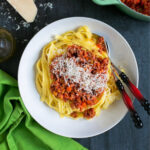

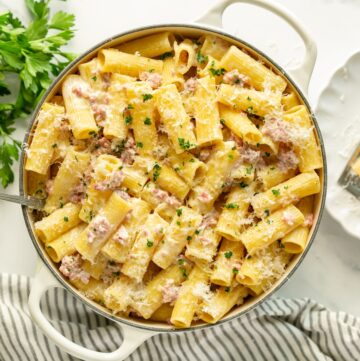
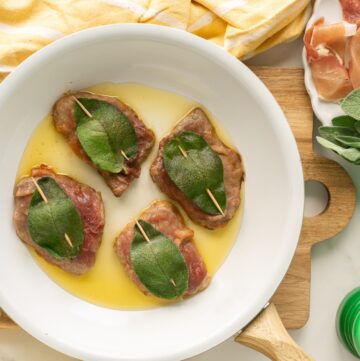

Jack Loss says
I have copied 3 other bolognese recipes because I felt the real recipe didn't use ground beef. I'm glad to see a recipe that uses diced beef, I don't thing the Italians in the 1500's had ground beef. I will use this recipe to build on. It's the only one that didn't use ground beef. I gave it 5 stars I hope. Wasn't sure how their rating system worked.
Andrea says
Hi Jack, thank you so much for your comment. Indeed, prepackaged ground beef should be really the last resort when making bolognese, as the quality of the meat really affects the result. I hope you'll like this recipe as much as my family does!
Dave says
This was a real winner with my wife and kids.The depth of flavour achieved from such a small list of ingredients is amazing. I will never make my own anglicised version of bolognese again!
I'm not sure if we are greedy or i didn't serve enough pasta with it (75g per person), as we ate all six servings between four with ease!
Andrea says
So happy to hear that Dave!